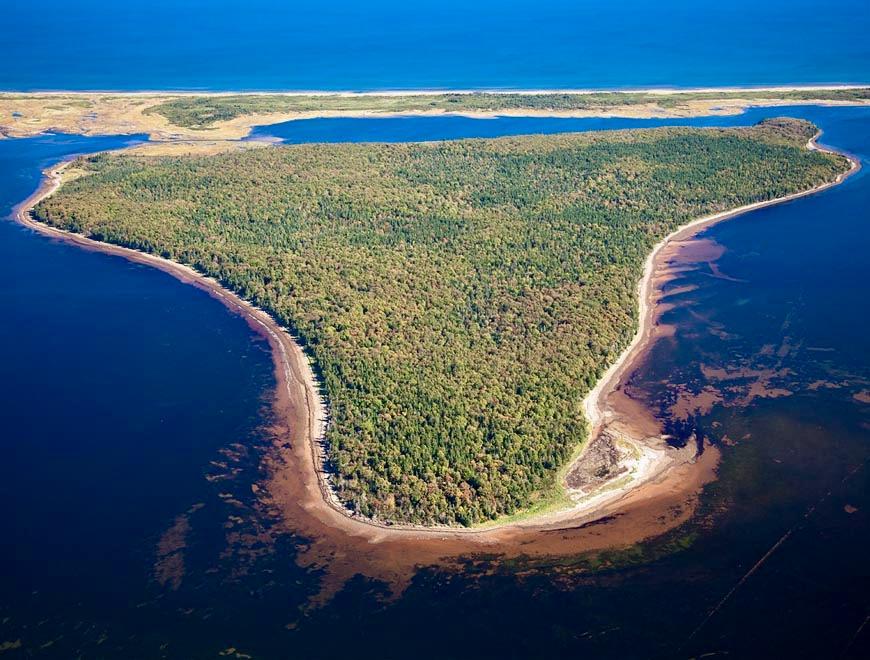
An aerial view of the sandhills with the islands of Pituamkek behind them/Epekwitk Assembly of Councils
The sand dunes of Pituamkek form one of the most ecologically significant coastal dune ecosystems in Eastern Canada and these islands are of important cultural and historic significance to the Mi’kmaq of Prince Edward Island.
Now Canadians are being asked to weigh in on the feasibility assessment process to establish Pituamkek National Park Reserve in the area of Malpeque Bay that’s also known as the Hog Island Sandhills.
“The Mi'kmaq name Pituamkek honours our history and connection to the land through recognition of our beautiful language,” Chief Darlene Bernard of Lennox Island First Nation and Epekwitk Assembly of Councils co-chair said in a news release. “Pituamkek represents an opportunity for partnership between the PEI Mi'kmaq and the Governments of Canada and Prince Edward Island. We have a chance to preserve history, the environment and a vital part of our Mi'kmaq cultural heritage.”
Located in northwestern Prince Edward Island (Epekwitk), near the Lennox Island First Nation reserve, are a chain of islands known in the Mi’kmaq language as Pituamkek (Bee-doo-um-gek), which means “At the Long Sand Dune,” and in English as “Hog Island and the Sandhills.”

A map that shows the proposed national park reserve study area as of June 2021/Parks Canada
The islands stretch for 50 kilometres (30 miles) from east to west and form a protective barrier to the north of Malpeque and Casumpec Bays, which have rich fisheries. They help protect communities from the waves and storm impacts of the Gulf of St. Lawrence and, because of climate change, should be protected.
Pituamkek is home to a rare geological feature — the island’s only igneous rock formation, a volcanic incursion that’s more than 240 million years old. It’s home to threatened and endangered species, including the little brown bat, northern long-eared bat, piping plover and Gulf of St. Lawrence aster.
Since August 2019, the province of Prince Edward Island, Epikwitk Mi'kmaq and Parks Canada have been assessing the feasibility of this proposed national park reserve. Parks Canada and L'nuey, on behalf of the Epekwitk Assembly of Councils, have developed consultation materials and a public consultation plan that complies with required public safety measures regarding the COVID-19 pandemic.
The feasibility of establishing a national park reserve is assessed, in part, through extensive local engagement. This is the public’s opportunity to share their perspectives and ideas and ask questions. Partners, stakeholders and the public can provide input on key aspects such as area histories, current uses and future visions.
Canadians have until July 23 to take the public survey posted at the Pituamkek project website at www.parkscanada.gc.ca/pituamkek.

A location known as Iron Rock is home to Prince Edward Island's only igneous rock formation/Epekwitk Assembly of Councils
Chief Junior Gould of Abegweit First Nation, who is also Epekwitk Assembly of Councils co-chair, said his ancestors have long been stewards of the land. “We believe in the protection and preservation of Pituamkek, both environmentally and culturally. This will lead to a positive legacy for the Epekwitk Mi'kmaq, and all Islanders and Canadians of future generations.”
The project dates back to 2006 when representatives from the Mi’kmaq communities of PEI, Parks Canada and the Canadian Museum of History conducted a foot survey of Hog Island. Two confirmed archaeological sites were discovered and the cultural and ecological importance of the area, already known to the local Mi’kmaq community, was brought to the attention of government officials.
The Epekwitk Assembly of Councils developed and submitted a proposal to the federal Minister of Environment and Minister Responsible for Parks Canada to create a cooperatively-managed national park reserve or other type of protected area.
In 2009, a tripartite group made of representatives from the federal, provincial and Mi’kmaq governments began discussions to find mutually acceptable ways to protect the Pituamkek area. Dialogue involving the Epekwitk Assembly of Councils, the province of PEI and the Nature Conservancy of Canada (NCC) identified shared conservation goals for the area. Around this time, the NCC began acquiring parcels of land in the area for conservation.
In 2010, the First Nations leadership wrote a second letter to the Minister of the Environment requesting Parks Canada support their proposal. After review of the proposal and meetings between the parties, Parks Canada recognized the Pituamkek region as being of national significance and meriting consideration for protected status.
Since then, multiple organizations have worked together to acquire lands for conservation and to build relationships and additional support for the Pituamkek national park reserve project. The Mi’kmaq of PEI, through L’nuey (the Mi’kmaq rights-based initiative), the Nature Conservancy of Canada, Island Nature Trust and Parks Canada have each been instrumental.
After several years of advocacy from the Epekwitk Mi’kmaq, in August 2019, a historic tripartite announcement from the Province of Prince Edward Island, Epikwitk Mi’kmaq and Parks Canada formally launched the undertaking of a feasibility assessment for the proposed national park reserve in Pituamkek. The public consultation process was slated to begin in early 2020, but was delayed due to the COVID-19 pandemic.
Once the feasibility assessment is complete and there is agreement on a formal park concept, the next step is negotiating a Memorandum of Understanding (MOU), before moving to negotiations of a formal establishment agreement.
While there may be opportunities for social distancing compliant in-person meetings through this engagement process, the majority of public input will be gathered online.

 Support Essential Coverage of Essential Places
Support Essential Coverage of Essential Places




Comments
These reserves and protected areas are so incredibly valuable, they must be maintained for future generations.
I stand with the Mi'kmaq people!
Do it up